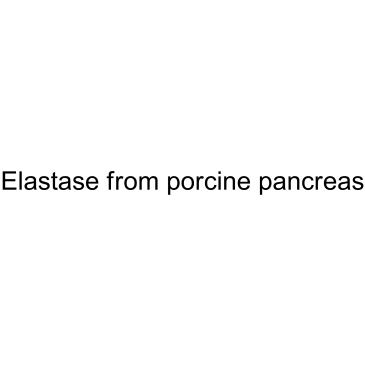Elastase from porcine pancreas |
| Catalog No.GC61737 |
Elastase from porcine pancreas (PPE), as one of the most prominent serine proteases,it can induce protease antiprotease imbalance and has been applied in an animal model of emphysema and Chronic pulmonary obstructive disease (COPD).
Products are for research use only. Not for human use. We do not sell to patients.

Cas No.: 39445-21-1
Sample solution is provided at 25 µL, 10mM.
Elastase from porcine pancreas (PPE), as one of the most prominent serine proteases,it can induce protease antiprotease imbalance and has been applied in an animal model of emphysema and Chronic pulmonary obstructive disease (COPD).It has 240 amino acids and a molecular weight of 26 kD. The conserved active site of elastase consists of three residues of serine 214, histidine 71, and aspartate 119 [1-3].
Elastase from porcine pancreas (0-60 mU/ml;24 h) treatment increased placenta growth factor (PlGF) expression and secretion in LE cells[4].
Elastase from porcine pancreas (100 mU/ml; weekly for one month;i.p) instillation increase PlGF expression, activation of JNK and p38 MAPK, and PlGF secretion in the pulmonary cells of mice[4]. Elastase from porcine pancreas can induces emphysema in hamsters[5].
References:
[1]. Shapiro SD. Animal models for COPD. Chest 2000; 117: 223S-227S.
[2]. M. WÜrtele, M. Hahn, K. Hilpert, W. HÖhne. Acta Crystallogr. D Biol. Crystallogr., 56 (2000), p. 520
[3]. Shotton DM, et, al. Amino-acid sequence of porcine pancreatic elastase and its homologies with other serine proteinases. Nature. 1970 Feb 28;225(5235):802-6.
[4]. Hou HH, Cheng SL, et, al. Elastase induced lung epithelial cell apoptosis and emphysema through placenta growth factor. Cell Death Dis. 2013 Sep 5;4(9):e793. doi: 10.1038/cddis.2013.329. PMID: 24008737; PMCID: PMC3789187.
[5]. Stone PJ, Lucey EC, et, al. Lnduction and exacerbation of emphysema in hamsters with human neutrophil elastase inactivated reversibly by a peptide boronic acid. Am Rev Respir Dis. 1990 Jan;141(1):47-52. doi: 10.1164/ajrccm/141.1.47. PMID: 2297186.
Average Rating: 5 (Based on Reviews and 21 reference(s) in Google Scholar.)
GLPBIO products are for RESEARCH USE ONLY. Please make sure your review or question is research based.
Required fields are marked with *




















